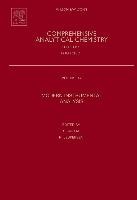Read more
Informationen zum Autor Satinder Ahuja earned his Ph.D. in analytical chemistry from the University of the Sciences! Philadelphia. He worked for Novartis Corp. in various leadership positions for over 25 years while simultaneously teaching and guiding research as an adjunct professor at Pace University for over 10 years. As president of Ahuja Consulting! he advises on quality issues relating to chemicals/pharmaceuticals and water. Dr. Ahuja has published numerous papers and more than eighteen books. Two of his latest books are entitled "Water Reclamation and Sustainability" (Elsevier) and Comprehensive "Water Quality and Purification" (Elsevier). Others include "Monitoring Water Quality: Pollution Assessment! Analysis! and Remediation" (Elsevier! 2013); "Novel Solutions to Water Pollution" (ACS Symposium Volume! 2013); "Handbook of Water Purity and Quality" (Elsevier! 2009); and "Arsenic Contamination of Water: Mechanism! Analysis! and Remediation" (Wiley! 2008). A member of the executive committee of Rivers of the World Foundation (ROW)! Dr. Ahuja is an expert on improving water quality and has organized numerous global symposia on this topic (American Chemical Society! UNESCO! etc.) In 2013! he gave a lecture on the nexus of food! energy! and water and chaired a symposium on the subject for the American Chemical Society meeting in New Orleans. Klappentext Modern Instrumental Analysis covers the fundamentals of instrumentation and provides a thorough review of the applications of this technique in the laboratory. It will serve as an educational tool as well as a first reference book for the practicing instrumental analyst. The text covers five major sections: 1. Overview! Sampling! Evaluation of Physical Properties! and Thermal Analysis2. Spectroscopic Methods 3. Chromatographic Methods 4. Electrophoretic and Electrochemical Methods 5. Combination Methods! Unique Detectors! and Problem Solving Each section has a group of chapters covering important aspects of the titled subject! and each chapter includes applications that illustrate the use of the methods. The chapters also include an appropriate set of review questions. Zusammenfassung Covers the fundamentals of instrumentation and provides a review of the applications of this technique in the laboratory. This book serves as an educational tool as well as a reference book for the practicing instrumental analyst. Inhaltsverzeichnis Chapter 1. Overview (S. Ahuja). Chapter 2. Sampling and sample preparation (S. Ahuja! D. Diehl). Chapter 3. Evaluation of basic physical properties (N. Jespersen). Chapter 4. Thermal analysis (H.G. Brittain! R.D. Bruce). Chapter 5. General principles of spectroscopy and spectroscopic analysis (N. Jespersen). Chapter 6. Near-infrared spectroscopy (E.W. Ciurczak). Chapter 7. X-ray diffraction and x-ray fluorescence (H.G. Brittain). Chapter 8. Atomic spectroscopy (T.H. Risby). Chapter 9. Emission methods (C.H. Lochmuller). Chapter 10. Nuclear magnetic resonance spectroscopy(L. Lohr et al.). Chapter 11. Mass spectrometry (D.J. Burinsky). Chapter 12. Theory of separation methods (C.H. Lochmuller). Chapter 13. Thin-layer chromatography (P.M. Grillini). Chapter 14. Gas chromatography (N.H. Snow). Chapter 15. High-pressure liquid chromatography (S. Ahuja). Chapter 16. Supercritical fluid chromatography (M.E.P. McNally). Chapter 17. Electromigration methods: origins! principles! and applications (M. Jimidar). Chapter 18a. Potentiometry (M. Telting-Diaz! Yu Qin). Chapter 18b.Voltammetry: Dynamic electrochemical techniques (A. Hussam). Chapter 19. Hyphenated methods (T.R. Sharp! B.L. Marquez). Chapter 20a. Optical sensors (E. Wang). Chapter 20b. Bioactivity detectors (S.M. Ford). Chapter 20c. Drug detectors (S.M. Ford). Chapter 21. Problem solving and guidelines for method selection (A.H. Ullman! D.E. Raynie). ...

